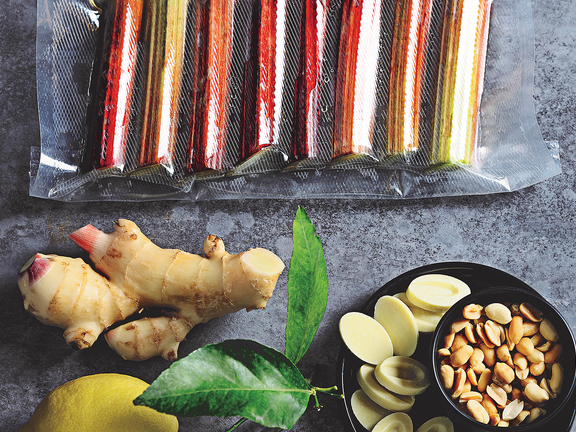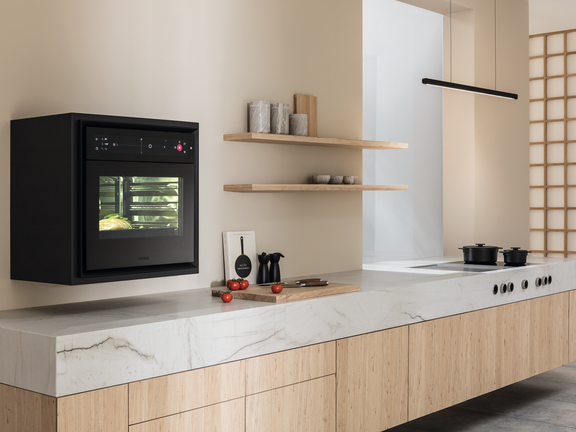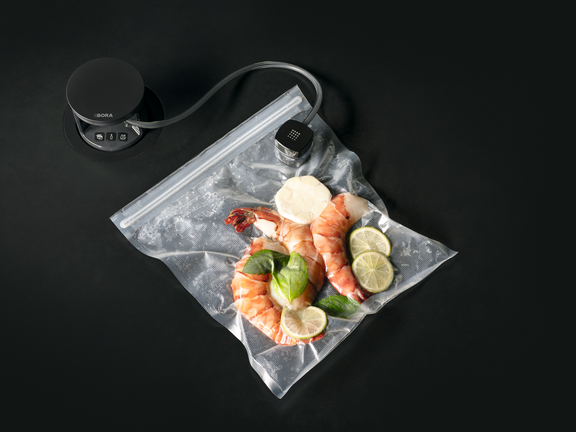

Sous-vide cooking is the thoughtful way to prepare meat, fish and vegetables.
The term comes from the French and means "under vacuum". This describes the method exactly: With sous-vide cooking, you vacuum-seal the ingredients and prepare them in a water bath or under steam at low temperatures. Depending on the type of ingredients, the cooking process for the airtight packaged food takes between around one and 24 hours - and the results are impressive. Thanks to the low heat and gentle cooking process, you can enjoy intense flavours and optimally preserved nutrients. We reveal how to cook vegetables, fish and meat sous-vide.
The fact that cooking does not necessarily require high temperatures was already known at the end of the 18th century. The physicist Benjamin Thompson first tested a cooking method using warm air in 1799. To do this, he put meat in a machine that was originally intended for drying food. After a few hours, he was surprised to discover that the meat was cooked to perfection and tasted simply delicious.

However, it would take a few hundred years before the low arm method became established. From the 1960s onwards, vacuum cooking became established as a preservation method, and in the mid-1970s French and American chefs rediscovered and perfected vacuum cooking.
Sous-vide cooking has also become increasingly popular in private households in recent years. There are various reasons for this: On the one hand, there are appliances on the market for sous-vide cooking that are characterised by their ease of use and can also be easily operated by amateur cooking enthusiasts. Secondly, word has got around that vacuum cooking leads to deliciously succulent, flavoursome results .
Sous-vide cooking only requires a few simple steps and a little time. First vacuum-seal the ingredients, then place them in a water bath or in the steamer and activate the desired cooking time. Now you can sit back and relax or take care of other kitchen tasks until the end of the cooking time has been reached. As soon as the food has reached its core temperature, this is kept constant. Then remove the ingredients and arrange them or process them further.
Little heat and lots of time: This is the formula that ensures irresistibly delicious results when vacuum cooking. Whether you are preparing vegetables or meat, all dishes are cooked to perfection. This is just one of the many advantages that make this cooking method so popular. You also benefit from these plus points:

Various appliances are suitable for preparation at low heat:
The core temperature and cooking time are decisive for the results of sous vide cooking. The thickness of the food also plays a role with meat and fish. The rule of thumb when cooking meat sous vide is: One centimetre takes about an hour to cook.
Good to know: Even if the food remains in the water or steam bath for longer, it will still be perfectly cooked. In principle, overcooking is not possible with the sous vide method. The minimum duration is more important so that you can enjoy optimum results. So how long should different ingredients be cooked sous vide? The table provides orientation:
| Ingredient | desired degree of doneness | core temperature | cooking time |
|---|---|---|---|
| beef | medium rare | 50-55 °C | approx. 60 min |
| Medium | 55-57 °C | approx. 60 min | |
| Medium well | 57-60 °C | approx. 60 min | |
| Chicken | - | 70 °C | approx. 90 min |
| Lamb (fillet) | Medium rare | 52-55 °C | approx. 40 min |
| Medium | 55-60 °C | approx. 40 min | |
| Medium well | 60-65 °C | approx. 40 min | |
| Fish (e.g. salmon) | Glazed | 38-40 °C | approx. 30 min |
| Fork tender | 45-45 °C | approx. 30 min | |
| Firm | 42-50 °C | approx. 30 min | |
| Well done | 46-55 °C | approx. 30 min |
Important: Chicken can also be cooked sous-vide at lower temperatures than 70 °C. However, to avoid the risk of salmonella, you should briefly fry it again before serving.
The times given refer to pieces of meat and fish one to two centimetres thick. Thicker qualities require a correspondingly longer cooking time.
You can also cook vegetables sous vide - with the following cooking times and core temperatures:
| Vegetable type | Core temperature | Cooking time |
|---|---|---|
| Artichokes | 85 °C | approx. 50 min |
| Cauliflower | 85 °C | approx. 40 min |
| Chicory | 85 °C | approx. 60 min |
| Fennel | 85 °C | approx. 50 min |
| Carrots | 85 °C | approx. 60 min |
| Beetroot | 85 °C | approx. 60 min |
| Asparagus (white) | 85 °C | approx. 75 min |
| Asparagus (green) | 85 °C | approx. 40 min |
| Onions | 85 °C | approx. 50 minutes |

With sous-vide, ingredients cook slowly and gently. However, roasting flavours cannot be produced using this method. You then conjure these up: If you want to cook steaks sous-vide, briefly sear the meat after vacuum cooking to activate delicious roasted flavours.
If you want to store the food after vacuum cooking for longer, cool it down as quickly as possible, for example by placing it in ice water for a few This stops the cooking process and prevents germs from multiplying.
Sous-vide cooking is a method by which food is vacuum-sealed and then cooked at low core temperatures in a bain marie or steam.
Virtually all meat and fish varieties and many kinds of vegetables are suited to sous-vide cooking. The only exception is soft varieties like tomatoes. Poultry must be cooked through, for instance, by briefly searing it before serving.
You should ideally add herbs and spices to the vacuum bag, where they will keep their flavour perfectly.
If you have a steam oven on which you can precisely control the temperature, it is possible. To ensure perfect results, it’s important to cook sous-vide on a low heat at a stable temperature.
Sous-vide cooking in a steamer is a popular alternative to the bain marie. The following also applies here: the appliance should allow for low temperatures that can be precisely controlled.
To cook sous-vide, you need a vacuum sealer, the corresponding bags and an appliance for cooking sous-vide (steam oven, steamer or sous-vide stick).
Vacuum sealing ensures that the food is airtight when packaged. It does not come into contact with water or steam and neither liquid nor flavours can escape. This achieves succulent, flavoursome results.